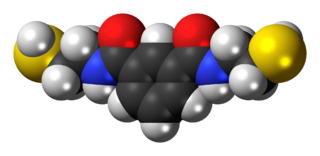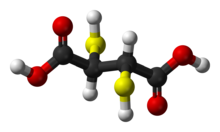
A poison is any chemical substance that is harmful or lethal to living organisms. The term is used in a wide range of scientific fields and industries, where it is often specifically defined. It may also be applied colloquially or figuratively, with a broad sense.

Arsenic poisoning is a medical condition that occurs due to elevated levels of arsenic in the body. If arsenic poisoning occurs over a brief period of time, symptoms may include vomiting, abdominal pain, encephalopathy, and watery diarrhea that contains blood. Long-term exposure can result in thickening of the skin, darker skin, abdominal pain, diarrhea, heart disease, numbness, and cancer.
Chelation is a type of bonding of ions and molecules to metal ions. It involves the formation or presence of two or more separate coordinate bonds between a polydentate ligand and a single central metal atom. These ligands are called chelants, chelators, chelating agents, or sequestering agents. They are usually organic compounds, but this is not a necessity.

Mercury poisoning is a type of metal poisoning due to exposure to mercury. Symptoms depend upon the type, dose, method, and duration of exposure. They may include muscle weakness, poor coordination, numbness in the hands and feet, skin rashes, anxiety, memory problems, trouble speaking, trouble hearing, or trouble seeing. High-level exposure to methylmercury is known as Minamata disease. Methylmercury exposure in children may result in acrodynia in which the skin becomes pink and peels. Long-term complications may include kidney problems and decreased intelligence. The effects of long-term low-dose exposure to methylmercury are unclear.

Chelation therapy is a medical procedure that involves the administration of chelating agents to remove heavy metals from the body. Chelation therapy has a long history of use in clinical toxicology and remains in use for some very specific medical treatments, although it is administered under very careful medical supervision due to various inherent risks, including the mobilization of mercury and other metals through the brain and other parts of the body by the use of weak chelating agents that unbind with metals before elimination, exacerbating existing damage. To avoid mobilization, some practitioners of chelation use strong chelators, such as selenium, taken at low doses over a long period of time.

Dimercaprol, also called British anti-Lewisite (BAL), is a medication used to treat acute poisoning by arsenic, mercury, gold, and lead. It may also be used for antimony, thallium, or bismuth poisoning, although the evidence for those uses is not very strong. It is given by injection into a muscle.

Penicillamine, sold under the brand name of Cuprimine among others, is a medication primarily used for the treatment of Wilson's disease. It is also used for people with kidney stones who have high urine cystine levels, rheumatoid arthritis, and various heavy metal poisonings. It is taken by mouth.

Arsanilic acid, also known as aminophenyl arsenic acid or aminophenyl arsonic acid, is an organoarsenic compound, an amino derivative of phenylarsonic acid whose amine group is in the 4-position. A crystalline powder introduced medically in the late 19th century as Atoxyl, its sodium salt was used by injection in the early 20th century as the first organic arsenical drug, but it was soon found prohibitively toxic for human use.
Acrodynia is a medical condition which occurs due to mercury poisoning. The condition of pain and dusky pink discoloration in the hands and feet is due to exposure or ingesting of mercury. It was known as Pink Disease before it was accepted that it was just mercury poisoning. The word acrodynia is derived from the Greek: ακρος, which means end or extremity, and Greek: οδυνη, which means pain. As such, it might be (erroneously) used to indicate that a patient has pain in the hands or feet. The condition is known by various other names including hydrargyria, mercurialism, erythredema, erythredema polyneuropathy, Bilderbeck's, Selter's, Swift's and Swift-Feer disease.

2,3-Dimercapto-1-propanesulfonic acid and its sodium salt are chelating agents that form complexes with various heavy metals. They are related to dimercaprol, which is another chelating agent.

Metal toxicity or metal poisoning is the toxic effect of certain metals in certain forms and doses on life. Some metals are toxic when they form poisonous soluble compounds. Certain metals have no biological role, i.e. are not essential minerals, or are toxic when in a certain form. In the case of lead, any measurable amount may have negative health effects. It is often thought that only heavy metals can be toxic, but lighter metals such as beryllium and lithium may also be in certain circumstances. Not all heavy metals are particularly toxic, and some are essential, such as iron. The definition may also include trace elements when abnormally high doses may be toxic. An option for treatment of metal poisoning may be chelation therapy, a technique involving the administration of chelation agents to remove metals from the body.

Delafloxacin sold under the brand name Baxdela among others, is a fluoroquinolone antibiotic used to treat acute bacterial skin and skin structure infections.

BDTH2 (also called BDET and BDETH2; trade names B9, MetX, and OSR#1) is an organosulfur compound that is used as a chelation agent. It is a colourless solid. The molecule consists of two thiol groups and linked via a pair of amide groups.

A DMSA scan is a radionuclide scan that uses dimercaptosuccinic acid (DMSA) in assessing renal morphology, structure and function. Radioactive technetium-99m is combined with DMSA and injected into a patient, followed by imaging with a gamma camera after 2-3 hours. A DMSA scan is usually static imaging, while other radiotracers like DTPA and MAG3 are usually used for dynamic imaging to assess renal excretion.

In organic chemistry, a dithiol is a type of organosulfur compound with two thiol functional groups. Their properties are generally similar to those of monothiols in terms of solubility, odor, and volatility. They can be classified according to the relative location of the two thiol groups on the organic backbone.
Arsenic biochemistry refers to biochemical processes that can use arsenic or its compounds, such as arsenate. Arsenic is a moderately abundant element in Earth's crust, and although many arsenic compounds are often considered highly toxic to most life, a wide variety of organoarsenic compounds are produced biologically and various organic and inorganic arsenic compounds are metabolized by numerous organisms. This pattern is general for other related elements, including selenium, which can exhibit both beneficial and deleterious effects. Arsenic biochemistry has become topical since many toxic arsenic compounds are found in some aquifers, potentially affecting many millions of people via biochemical processes.

Jeffrey A. Brent is a medical toxicologist who is a distinguished clinical professor of medicine and emergency medicine at the University of Colorado, School of Medicine. In addition, he is a professor at the Department of Environmental and Occupational Health at the Colorado School of Public Health. He is also the past president of the American Academy of Clinical Toxicology, was editor in chief of the journal Toxicological Reviews, and was a member of the board of directors of the American College of Medical Toxicology. Previously, most of Brent's research focused on the use of fomepizole as a treatment for both methanol and ethylene glycol poisoning, and he led a trial of this drug which resulted in the FDA approving it in December 1997. Currently, Brent serves as Director of the Toxicology Investigators Consortium, an NIH and FDA supported multi center research and surveillance group. Brent is also a senior editor of "Critical Care Toxicology: Diagnosis and Management of the Critically Poisoned Patient," originally published in 2005, and now in its second edition, which was published in 2017.
Hurair Vasken Aposhian was a Ph.D. toxicologist and an emeritus professor of molecular and cell biology at the University of Arizona, a post he held beginning in 1975. He is also a former professor of pharmacology at the medical school at said university. He received his bachelor's degree in chemistry, at Brown University, 1948. He received a master's degree and a PhD in physiological chemistry at the University of Rochester, where he published some scientific studies about the synthesis of isoalloxazine ring-containing compounds. He did a postdoctoral with Nobel Laureate Arthur Kornberg in the department of biochemistry at Stanford University School of Medicine. He has done sabbatical scholar-in-residence at MIT and at the University of California at San Diego. He is best known for his pioneering work on Succimer and Unithiol in the treatment of arsenic, mercury, lead and other heavy metals leading to FDA approval of succimer in childhood lead poisoning at levels over 40 ug/dl. Previous posts he had held include at Vanderbilt, Tufts University, and the University of Maryland. His views about mercury in vaccines and in dental amalgams go against the consensus of the medical community and are controversial.

Sodium calcium edetate, also known as edetate calcium disodium among other names, is a medication primarily used to treat lead poisoning, including both short-term and long-term lead poisoning. Sodium calcium edetate came into medical use in the United States in 1953.

Sodium thiosulfate, also spelled sodium thiosulphate, is used as a medication to treat cyanide poisoning, pityriasis versicolor, and to decrease side effects from cisplatin. For cyanide poisoning, it is often used after the medication sodium nitrite and is typically only recommended for severe cases. It is either given by injection into a vein or applied to the skin.























